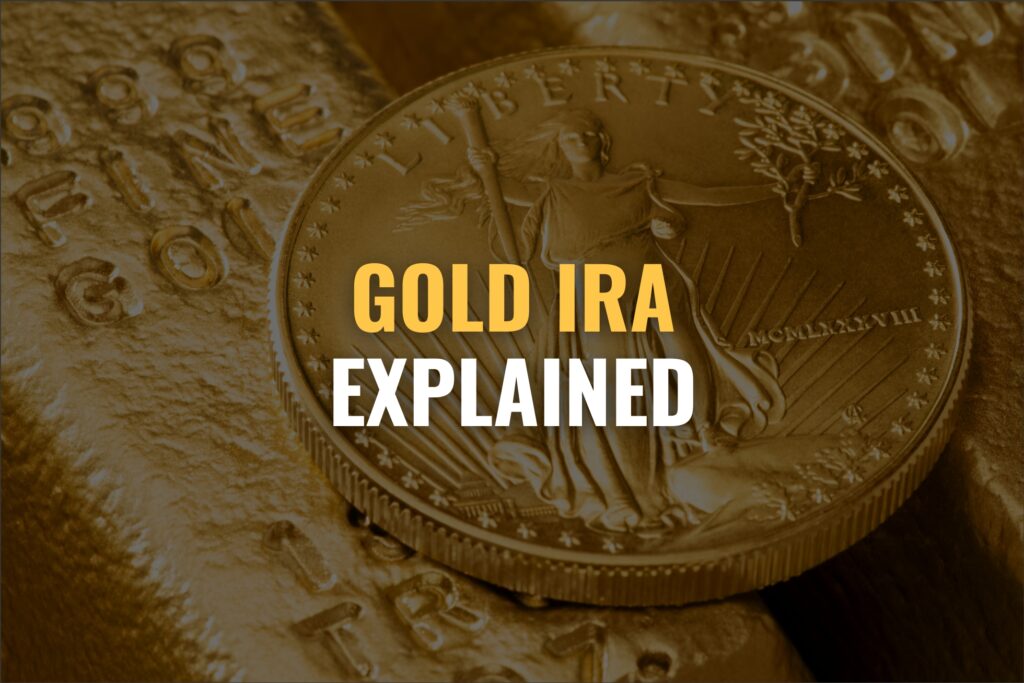What is a Gold IRA?

Gold has long been a favored option for investors. Its lasting value and tendency to increase in worth, especially during times of rising prices, stock market declines, or geopolitical uncertainty, make it a dependable and profitable choice.
In today’s economic environment, marked by struggling global markets, record-high debt levels, and persistent inflation, adding gold to a retirement plan is a wise decision. Incorporating gold into a self-directed precious metals IRA can amplify the advantages of this investment.
This approach allows you to diversify your retirement savings with physical gold while benefiting from the tax perks of an IRA. However, to fully capitalize on these benefits, it’s crucial to understand the details of a gold IRA investment.
This article will guide you through everything you need to know about gold IRAs, from their definition and functionality to tax considerations and beyond.
Brief Summary
- A Gold Individual Retirement Account (IRA) is a specialized retirement plan that permits investors to own physical gold and other approved precious metals. This account serves as a safeguard against economic ups and downs and rising prices.
- To set up a Gold IRA, you need to pick a custodian who specializes in self-directed IRAs and is licensed to handle precious metals. The custodian ensures the account follows IRS rules, including which metals can be held and how they must be stored.
- You can opt for a traditional Gold IRA, where your investments grow tax-free until you withdraw funds, at which point taxes apply. Alternatively, a Roth Gold IRA requires you to pay taxes on contributions upfront, but withdrawals during retirement are tax-free.
- Be mindful of the costs involved. These may include fees charged by the custodian, expenses for storing the physical metals, and possible setup charges. Such costs can affect the overall performance of your investment.
Understanding IRAs
An Individual Retirement Account, or IRA, is a savings plan designed to help you build wealth for retirement with notable tax advantages. Many people mistakenly think an IRA is a standalone investment. In reality, it acts like a personal vault where you can store various assets, such as physical gold, stocks, mutual funds, or other financial instruments.
Unlike a 401(k), which is typically offered through an employer, an IRA is something you can set up independently. This means you don’t need to be an employee or business owner to open one, giving you greater flexibility. There are two primary types of IRAs:
- Traditional IRA
- Roth IRA
Each type comes with its own tax benefits and specific rules for investments. Before choosing an account, it’s important to carefully review these guidelines to ensure it aligns with your financial goals.
So What is a Gold IRA?
A Gold IRA, sometimes called a precious metals IRA, operates much like a standard Individual Retirement Account, sharing the same rules for contributions and withdrawals. The key difference lies in its focus: a Gold IRA holds physical assets, such as gold, silver, platinum, or palladium in the form of coins or bars, instead of paper-based investments like stocks or bonds.
By opening a self-directed IRA, you gain the flexibility to choose between a traditional or Roth Gold IRA. This allows you to select an account type that matches your tax preferences and investment objectives. Later in this article, we’ll dive deeper into the specifics of these Gold IRA options.
Advantages of a Gold IRA
A Gold IRA combines the stability of owning physical gold with the tax benefits of an IRA, creating a solid foundation for financial security in retirement. Let’s break down the main benefits:
Protection Against Inflation: Gold serves as a strong shield against inflation. When the dollar’s value drops, gold prices often rise, holding their worth through economic shifts like changing interest rates. Over time, this stability can lead to solid returns.
Tax Advantages: The tax benefits depend on the type of Gold IRA you choose. With a traditional Gold IRA, contributions are typically tax-deductible, but withdrawals are taxed. In contrast, Roth Gold IRA contributions are made with after-tax dollars, allowing tax-free withdrawals in retirement.
Safeguarding Wealth: During economic uncertainty, gold tends to maintain its value, unlike stocks or mutual funds, which can be more volatile. This makes a Gold IRA a reliable option for protecting your savings, no matter the market’s ups and downs.
Portfolio Diversification: A well-rounded investment strategy includes a mix of high-risk, high-reward assets and safer, more stable ones. Gold falls into the latter category. While it may not always deliver dramatic gains, it helps balance riskier investments, reducing potential losses and stabilizing your overall portfolio.
Gold’s Role in Wealth Protection
If you’re new to investing in gold, you might ask, “How effective is gold at shielding wealth and countering inflation?” A look at history provides a clear answer. For centuries, gold has served as a form of currency, from ancient coins to modern bars. Its enduring value and scarcity make it a trusted asset for preserving wealth over time.
Consider this scenario: Suppose you bought three gold bars 30 years ago or received them as an inheritance. Back then, their value might have seemed modest compared to today. Over the decades, currencies have lost significant purchasing power due to inflation, but gold has held steady. Those same three bars would likely be worth far more now, while the equivalent amount of cash from 30 years ago might not even buy a single bar today.
This example highlights why gold is prized for its stability. Its limited supply and resilience against economic shifts make it a powerful tool for protecting wealth, particularly during periods of high inflation when currencies weaken. Over long timeframes, gold consistently proves its worth as a reliable safeguard.
Gold IRA vs. Traditional and Roth IRA: Key Differences
What sets a Gold IRA apart from a traditional or Roth IRA? The primary distinction lies in the types of assets each account can hold. As mentioned earlier, a Gold IRA allows you to invest in physical precious metals, such as gold, silver, platinum, or palladium, while traditional and Roth IRAs typically hold paper-based assets like stocks, bonds, or mutual funds.
Beyond this core difference, both Gold IRAs and traditional/Roth IRAs serve as retirement savings vehicles, each with specific rules and investment requirements.

Traditional Gold IRA vs. Roth Gold IRA
When choosing a Gold IRA, you can select between a traditional Gold IRA or a Roth Gold IRA. Below are key factors to consider when deciding which option suits your financial goals.
Eligibility
Traditional Gold IRAs have no income limits, making them accessible to anyone. In contrast, Roth Gold IRAs impose income caps: $153,000 for single filers and $228,000 for married couples filing jointly. Your income also affects how much of your Roth IRA contribution you can deduct from your taxes each year.
Contributions
Contributions to a Roth Gold IRA are taxed when you make them, meaning you pay taxes upfront. On the other hand, contributions to a traditional Gold IRA are typically tax-deductible, so you don’t pay taxes on them until withdrawal. We’ll cover contribution limits for both accounts later in this article.
Required Minimum Distributions (RMDs)
A Required Minimum Distribution (RMD) is the amount of money or asset value you must withdraw annually from your account once you reach retirement age. For traditional Gold IRAs, RMDs must begin at age 72. Roth Gold IRAs, however, have no RMD requirements, giving you more flexibility in managing your savings. Be aware that taking distributions from a traditional Gold IRA too early or too late can trigger tax penalties, which we’ll discuss in more detail later.
How to Establish a Gold IRA
After learning the benefits and essentials of a gold IRA, you’re ready to take the next step and invest. To do this correctly, you must understand the process of opening a gold IRA account while following IRS regulations. Below are the key steps to consider:
1. Select a Custodian
A custodian is a trusted financial institution or company responsible for managing your gold IRA funds. This partner will guide you through every stage of setting up a self-directed gold IRA, from opening the account to funding it and purchasing your chosen precious metals.
Choose an IRS-approved custodian that complies with all IRS rules for IRA investments. Before deciding, research their fees and services to ensure they align with your investment goals. A reliable custodian makes the process smooth and tailored to your needs.
2. Fund Your Account
Once you’ve selected a custodian, you’ll need to add funds to your gold IRA. You can do this by transferring or rolling over money from an existing retirement account, like a traditional IRA or 401(k). This step can be complex, so consult your custodian and consider professional advice to ensure a seamless process.
Verify that your custodian supports your preferred funding method, whether it’s a cash contribution or a rollover from another retirement plan.
3. Choose Precious Metals
Next, decide which precious metals to include in your gold IRA. IRS rules allow only specific gold, silver, platinum, and palladium assets that meet strict purity requirements.
To stay compliant, ask your custodian for a list of IRS-approved metals and recommended suppliers. This ensures your investments meet the necessary standards and are eligible for your gold IRA.
4. Partner with a Precious Metals Dealer
Finally, select a reputable precious metals dealer to purchase your assets. Look for companies with a strong history of handling gold IRA investments. Compare their fees, services, and reputation to find a dealer that matches your budget and investment needs. A trustworthy dealer will provide quality assets and excellent support for your gold IRA journey.

Storing and Securing Your Gold IRA Assets
Once you’ve acquired physical gold or other precious metals for your IRA, you need to store them securely. According to IRS rules, these assets must be held in an approved depository or managed by a custodian. The storage provider you select must be IRS-approved and insured by the Federal Deposit Insurance Corporation (FDIC).
Additionally, the storage facility must meet specific IRS requirements for gold IRA storage. Here’s what you need to know:
- The storage location must maintain top-tier security measures. This includes round-the-clock monitoring, fire protection systems, and restricted access to ensure your assets are safe.
- Your chosen depository must have a formal agreement with the custodian managing your gold IRA. This agreement should outline how your precious metals will be stored and protected.
- The custodian is responsible for keeping detailed records of all transactions related to your IRA’s assets. They should also provide you with monthly statements. These reports will detail account activity, the current market value of each asset in your IRA, and any fees associated with maintaining the account.
To meet these storage standards, work closely with your custodian or depository before finalizing your choice. This ensures compliance with IRS regulations and gives you peace of mind knowing your investments are secure.
Tax Rules for Gold IRAs
When investing in a gold IRA, one critical factor to consider is the tax impact. Following IRS tax rules for gold IRA investments is essential to protect your returns over time. If you’re new to these tax policies, the comparison below outlines the key differences between Traditional and Roth Gold IRAs.
| Aspect | Traditional Gold IRA | Roth Gold IRA |
|---|---|---|
| Tax Advantages | Contributions and gains are tax-deferred, meaning you won’t pay taxes until withdrawal. | Taxes are paid on contributions upfront, allowing tax-free withdrawals later. |
| Early Withdrawals | Taking funds out before age 59½ triggers a 10% penalty, unless you qualify for exceptions. These exceptions include needs like medical expenses, buying your first home, or in case of death. Check the IRS guidelines on withdrawal exceptions to see if you can avoid this penalty. | Withdrawals are penalty-free only after holding the account for five years. Early withdrawals may face taxes or penalties. |
| Required Distributions | Starting at age 72, Traditional Gold IRAs require you to take Required Minimum Distributions (RMDs). Failing to take the correct amount results in a 50% tax penalty on the undistributed portion. | Roth Gold IRAs do not require RMDs for the original account holder. However, non-spouse beneficiaries must take RMDs, and failure to do so incurs a 50% tax penalty on the amount not withdrawn. |
Understanding these tax rules helps you choose the gold IRA type that best suits your financial goals and retirement plans.
Conclusion
Investing in a gold IRA is a wise choice for diversifying your retirement savings. It offers benefits like protecting your wealth and shielding against inflation, while also providing tax advantages based on the type of gold IRA you select.
To maximize these benefits, ensure you follow IRS regulations carefully. This approach helps you avoid tax issues and builds a stronger retirement portfolio with precious metals tailored to your long-term strategy.
